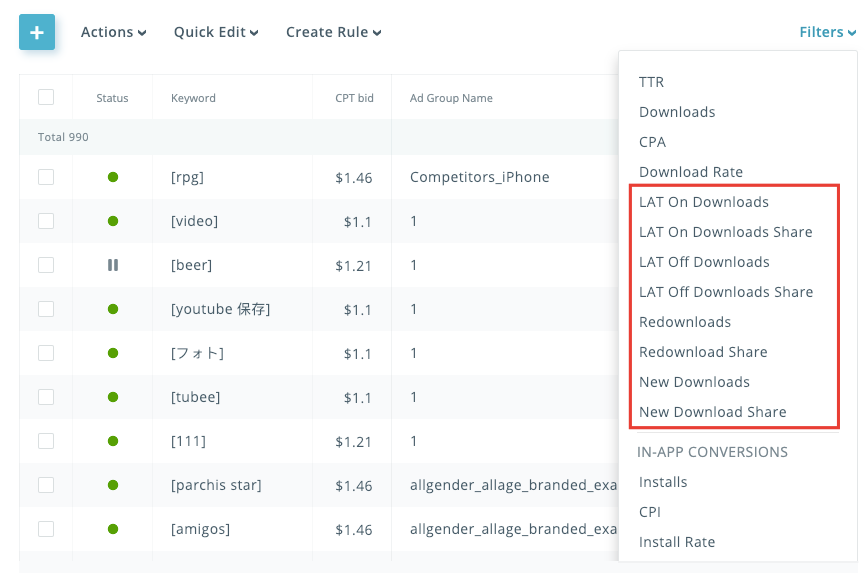Adding Transparency to Apple Search Ads – New Discrepancy Metrics
 Liza Knotko
Liza Knotko  Liza Knotko
Liza Knotko As we all know, Apple Search Ads gives app publishers a chance to get the prime spot in the App Store search results. This premium ad network is famous for its fraud-free environment, pre-qualified users and high conversion rate.
That’s all well and good, but it’s not always that easy to measure the return on the App Store ads spend. The thing is the difference between Apple Search Ads self-reports and data provided by Mobile Measurement Partners (MMPs) might reach from 30% to 70%.
The latest SearchAdsHQ update helps to shed light on such substantial discrepancy. 8 new metrics were introduced to add transparency to Apple Search Ads and assist in identifying the reasons behind data discrepancy
New SearchAdsHQ metrics help mobile marketers to better understand reasons for the discrepancy between the data on ad traffic volume provided by Apple Search Ads itself and mobile trackers (for example, now it’s possible to explain why Installs far exceed Downloads).
These metrics are essential if you want to properly measure the efficiency of app advertising. They provide more comprehensive information presenting a complete picture which leads to better optimization of Apple Search Ads.

The following SearchAdsHQ 8 metrics were added:
The first 4 metrics (LAT On Downloads, LAT Off Downloads, New Downloads and Redownloads) are taken from Apple directly. However, mind that SearchAdsHQ uses the term ‘Downloads’ instead of Apple’s ‘Conversions”.
The rest of the metrics (New Downloads Share, Redownloads Share, LAT On Downloads Share and LAT Off Downloads Share) can’t be found on your App Store ads dashboard as they’re calculated by SearchAdsHQ based on the data from Apple.

The best part about the update is that new Apple Search Ads discrepancy metrics are available on all SearchAdsHQ functional levels such as:
There is a range of differences in how Apple and mobile trackers register traffic from the App Store ads. In general, MMPs don’t consider a sizeable portion of Apple Search Ads traffic which results in the distortion of such important metrics as number of Installs, average cost-per-action (CPA), ROAS, Revenue, etc.
These very metrics are used by mobile marketers for the evaluation of Apple Search Ads efficiency and its optimization. New SearchAdsHQ metrics help you understand the reasons behind statistical discrepancy and calculate more accurate metrics for the App Store ads performance if necessary.
Let’s consider 2 basic discrepancy reasons and how you can deal with them using SearchAdsHQ metrics.

If a user with activated LAT installed an app after clicking on Apple Search Ads, they won’t be attributed to this traffic source by a MMP. As a result, users may use an app but these events are not reflected in Apple Search Ads statistics of a mobile tracker.
LAT On/ LAT Off metrics provided by SearchAdsHQ let you see how much traffic could’ve been not attributed to Apple Search Ads in the statistics of your mobile tracker due to activated Limit Ad Tracking.

The thing is mobile trackers don’t treat Redownloads as new downloads and keep attributing all events associated with them to a traffic source which brought the initial download. Thus, a publisher pays for an ad which brings a user who was their client once (and deleted the app at some point) but their mobile tracker doesn’t consider such traffic.
SearchAdsHQ metrics Redownloads/New downloads help you understand how much traffic could’ve been not reflected in Apple Search Ads statistics of a MMP as some downloads were repetitive.
Let’s deconstruct a simple example to see how it works.
Imagine the keyword «fitness» has the following statistics:
We can conclude that only half of the users which downloaded an app opened it eventually (performed an install). Yet, if we use SearchAdsHQ, we get additional metrics (Redownloads and LAT On Downloads):
Thus, we can conclude that there’s a possibility that at least 25 downloads (and 45 downloads at maximum) were converted into Installs after all. However, the tracker didn’t consider this data in its statistics.
It turns out that genuine statistics may differ from the initial one:
The evaluation of Apple Search Ads performance based on new numbers is way more impressive, isn’t it?
If you’re still in doubt whether to give the App Store ads a try, check out our Apple Search Ads Benchmarks report Q2-Q4 2020 which features the most important performance metrics such as TTR, CVR, CPT, CPA, etc.
As the above-mentioned example demonstrates, SearchAdsHQ update lets you see the full picture of Apple Search Ads performance and evaluate its efficiency. The introduction of new metrics is yet another step to creating the best platform for the App Store ads management which helps you scale profitability of Apple Search Ads and earn more doing less.